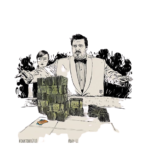This run is Emajor, deliberately so because it starts from the open string and runs up the fretboard.

Adding the slide in up to next scale will become natural with a little practice.

I’ve been making some effort to learn the basics and I think this is a great starting point that anybody can pick up a guitar and learn and perfect in an hr or so.
If you do this excercise in C Major in the same manner you would run out of frets (you can alter the starting point as you see fit) but in that way you would be playing only non flat or sharp notes eg cdefgabc so that you can get some grounding in learning where some (or all) the notes are, should you want to do that.
In Emajor, the notes you are playing are E, F♯, G♯, A, B, C♯, and D♯.
Every major key has a relative minor key that is the exact same notes and vice versa.
For E Major, the relative minor key is C#minor. A lot of people already know the pentatonic shapes on guitar and so it’s just very useful to keep this relative minor thing in mind because it opens up a lot of scales/patterns that you can use in addition to your standard major scale.
You can play the C#minor pentatonic shapes when playing in E major.
Hopefully, with a little practice, this little lesson will help someone out there open up the fretboard a bit. It’s important to realise that C#minor and E major are the exact same notes. It’s odd to accept that at first but it’s only really the starting and finishing point of the scale that defines the sound. Just believe that it’s the same notes as E major because it is.
You can find the relative minor of your major key by counting down 3 steps from your base key/note.
Here’s a random backing track in E Major that I thought has a nice chilled-out vibe you could practice the E major scales with. A lot of people like rock music but for me, the best type of backing track to practice with is something slow and chilled out so your brain isn’t getting too excited while you are trying to learn something. https://www.youtube.com/watch?v=ZHY4bSf3CnY
Even that track I find a bit distracting, the best type of backing track you can use is something that you create yourself so it fits to what you find more relaxing and generates more focus on learning while you select the chords.
Focusing on the scales/notes/patterns you are using is the only way to learn properly because once you start to enjoy what you are doing too much you will get carried away enjoying the tune you made and not learning anything. Going very very slowly is advised to really select where you are going rather than trying to fluke something.
Audacity is a great free program that I use when trying these types of learning exercises. You can play one simple chord progression > select all > effects > repeat and repeat it 50 times or whatever. Here is one I made myself that is nice and chilled to do the job. It’s E Bsus2 f#m. There’s a myriad of useful programs you could use but to just get started and do something is the only way to make progress, perhaps just record it on your phone and try to loop it somehow. Any mind blowing program you might find was likely made by someone who actually sat down, focused on what they were doing and actually tried to learn something.
Rock on Jimmy, enjoy my simple guitar lesson, you’re welcome.
Here are some pics of some learning material that I am working through at the moment that might be useful.








